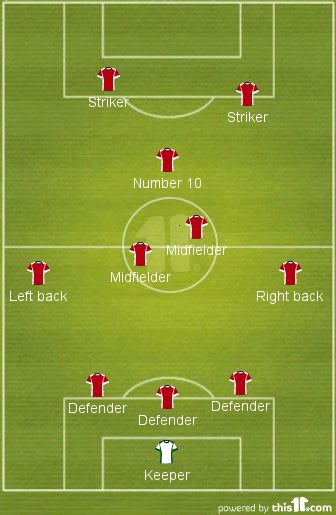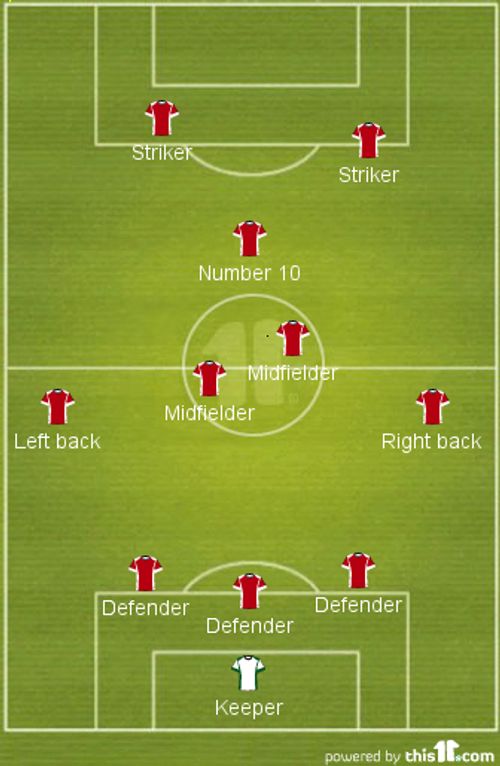
FIFA World Cup 2014: The resurgence of the 3-5-2 formation
The 3-5-2 or 5-3-2 has seen a new lease of life at the World Cup 2014. Top teams like Holland, Italy, Chile, Mexico and Costa Rica have deployed it and enjoyed success. Three centre back formations were pushed into obscurity before the world cup. European clubs have favoured formations like 4-3-3 and 4-2-3-1 heavily in recent times.
Italian clubs have perhaps been the best advocates, Juventus having used it to great success enroute to three title wins. Brendan Rodgers used a 3-5-2 at Liverpool for a short time to accommodate both Sturridge and Suarez. But it left them too exposed at the back and he dropped it.
At the World Cup though, master tacticians like Louis Van Gaal, Jorge Sampaoli and Cesare Prandelli have perfected and used it to their advantage. Netherlands and Chile cruised to victories over defending champions Spain using the 3-5-2 quite well. We look at the basic setup and tactical talking points of the 3-5-2 formation in more detail:
The basic set-up:

The 3-5-2 basically builds on the core foundation of a three man central defence and two wingbacks. Then there are two central midfielders and a number 10. One midfielder acts as a ball winner, one acts as a deep lying play maker. The number 10 is also said to be the most advanced play maker. Finally, there are the two forwards.
The three central defenders stay back at all times to provide ample cover defensively and allow the wingbacks to push up and attack. The central of the three central defenders is sometimes called the libero. He is essentially the spare man in defense while the other two central defenders mark the strikers. The libero has a free role.
He can become the deepest of the defenders and act as a sweeper to repel long balls thrown at the defense. He can also go further forward to mark an advanced playmaker or a number 10 and also act as a ball playing defender. The other two centre backs have a more fixed role.
The wingbacks are probably the most important part of this formation. They drop back to form a five man back line when in defence and the formation becomes a 5-3-2. While in attack, the fullbacks are assigned the main responsibility of providing width to the attack. They push up in attack to take up wide roles on the wing, and the formation becomes a 3-5-2. The wingbacks have to be the most hard-working ones on the pitch, running up and down the pitch for 90m inutes to support both the attack and the defence.
The two central midfielders are very important as well. Although, the full backs do become part of the midfield during attack, essentially it is still a two man midfield which increases the work load of the midfielders. Teams using this formation generally deploy one ball winner- a destroyer, he is good in the tackle and at breaking up opposition attacks. He is asked to tightly mark one of the opposition attackers.
The other midfielder is like a deep lying playmaker, aiming to build and influence play from deep. The number 10, also termed the most advanced playmaker. He aims to make direct passes to the forwards in the final third.
The forwards have to be able to hold up the play and allow midfield runners to get into good positions. They are also primarily tasked with scoring goals. The strikers can take up varying positions, one being the deep lying forward and one being the target man. Or one aiming to run channels in wide positions and other aiming to get at the end of crosses.
Teams using this formation generally aim to win the midfield battle, that's the purpose of sacrificing the normal back four. 3-5-2 is a good fit for teams who feel they have a good forward line but are weak in defense. 3-5-2 can allow them to pack the midfield and defense at different points of the game and give free roles to their forwards to score goals.
But the 3-5-2 needs great co-ordination and team work between all ten outfield players to work properly. If not, there could be huge gaps for the opposition to exploit, especially on the counter attack. The lack of true wide midfielders (wingers) means that teams can outnumber the wingbacks 2 vs 1 by using wingers. So the midfielders also need to cover for the full backs when they push forward in case of a counter attack.
It is quite a task getting the balance between all out attack and defence right with the 3-5-2. It can be good both for defense and attack minded teams. I present the case study of two teams who have got the 3-5-2 right in the World Cup 2014:
1: The Netherlands

The image shows the Netherlands’ line up against Spain. A 3-5-2, or a 3-4-3, as Van Gaal likes to put it. Blind and Janmaat are the wingbacks. De Jong was the ball winner while De Guzman was the playmaker.Robben and van Persie played centrally up front. The centre backs maintained a high line throughout the game in order to prevent space in between the defense and midfield which did not allow the Spanish tiki-taka to flourish. Although the result showed that this worked as the Spanish midfielders were stifled, the Dutch did have some nervous moments.
As is the norm with the 3-5-2, the full backs were the ones providing all the width. Both the fulbacks were instructed to put in a lot of direct passes and crosses to the forwards. Two such passes over the top by Blind led to the first two Dutch goals, the first being the spectacular header by van Persie and the second by Robben. In defence, the fullbacks were hugely helped by the fact that no Spanish player stayed wide and exploited the space. Both Iniesta and Silva, the designated wide players, are not really wingers. They aimed to cut inside and play in their usual way, which played into the hands of the Dutch.
Although Sneijder was tasked with the primary creative role, he didnt have much impact on the game. It was all about direct attacking. Robben and co got behind the Spanish defense quite easily on a number of occasions. Robben's role was very interesting. He was playing very high up the pitch trying to run at the defense in counter attacks. He was like the trequartista, an advanced playmaker given the free role, with no responsibility in defence. He was the most influential player in the game with his pace and trickery. van Persie aimed to stick to the centre backs and stretch the defence. His clinical finishing was at display.
It was all about maintaining a high line in defense, putting pressure on the midfield, putting in early crosses over the top of the defence from wide areas, and pace and power while attacking. It worked quite effectively and Spain were handed a drubbing.
2. Chile

Jorge Sampaoli has continued the trend set by Marco Biesla. Chile have been extrememly adventurous and tactically flexible. They are aggressive in their pressing and direct in attack, aiming to utilize the pace of Vargas and Sanchez. There was also a lot of movement and unpredictability from Chile. The forwards would move between wide positions and central. The number ten, Valvidia would move deep and draw centre backs towards him to create space for the strikers.
Chile usually played a version of the 5-2-1-2 which became a 3-4-1-2 in attack. Diaz was the deep lying playmaker. He has good ability on the ball to make passes and also can break up play and protect the back four. Vidal and Aranguiz would carry the ball forward from midfield. In the match against Spain, both Vidal and Aranguiz stuck tight and pressed the central midfielders which disrupted their passing rhythm. Sanchez and Vargas occupied the centre backs and made it tough for them to build from defence. Vidal and Aranguiz were usually the most advanced midfielders.
The fullbacks were both usually quite high up the pitch which made the team a very attacking one. But the fullbacks also formed the first line of pressing and upon losing the ball, they showed the energy to track back and form a flat five man defence. Sanchez was the key player here. He started centrally and usually stayed very high up the pitch and aimed to stretch the defence. He would also drift wide occasionally to exploit his good understanding with the rightback Isla.
Pedro was included in this match by del Bosque and was instructed to stay wide on the right. He aimed to provide lateral runs from the right behind the fullbacks. Spain did manage to create 2 vs 1 situations on the right quite a bit, but Azpilicueta is not the most adept at attacking and Chile managed to come out unscathed. Their good showing continued against Brazil in the round of 16 too, where they were unfortunately knocked out on penalties. They won many hearts during their time in the World Cup with their brave energetic displays.
These were just two of the teams who played a 3-5-2 in the World Cup. There were many others like Mexico, Costa Rica, Uruguay and Italy who played the 3-5-2 and its variations at different stages of the competition to good effect. The emergence, or, should we say, the resurgence of the five man defence has made the World Cup quite an interesting one in terms of tactics and I'm sure we will see more of the formation in club football too, in the near future.